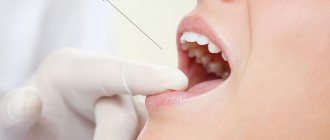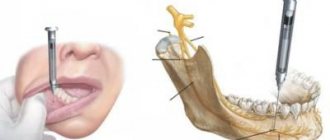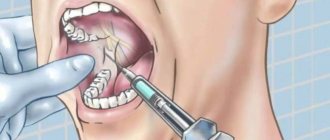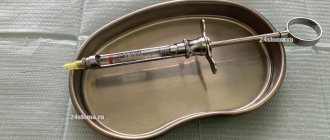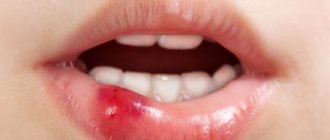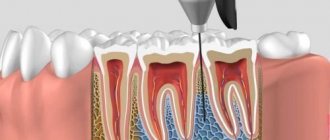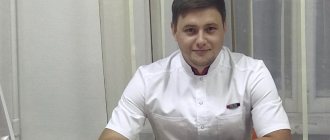In dental treatment, almost no manipulation is complete without pain relief.
At the moment, there are many types and subtypes of anesthesia, which differ in drugs, methods of administration and areas of use.
Anesthesia in dentistry is torusal – this is anesthesia that is performed on the lower jaw to block nerve fibers. In this case, the anesthesia itself is placed in the area of the torus - the ridge on the lower jaw, hence its name. Due to this, you can numb the teeth in the lower jaw with a small amount of the drug.
Indications for torusal anesthesia
Indications for this method of local anesthesia are:
- Treatment of teeth on the lower jaw
- Splinting the lower jaw after trauma
- Extractions on the lower jaw
- Treatment of pericoronitis
- Cleansing purulent foci
- Removal of tumors
- Surgeries in the area of TMJ
Contraindications include all the usual contraindications for local anesthesia - allergies, some mental and systemic diseases, as well as the psychological state of the patient - if you are very afraid of injections, then perhaps you should choose a different type of pain relief during treatment.
Anesthesia zone and anatomical features
Since the “mandibular” nerve is switched off, the patient receives the same set of sensations as with mandibular anesthesia: unilateral switching off of the teeth, mucous membrane and skin of the cheek, gums starting from 35 to 37 or from 45 to 47 (that is, from the second premolar to second molar in the middle).
The anatomical formation of the ridge or elevation consists of two bone cords that give off the condylar and coronoid processes. It is located above and anterior to the bony tongue of the jaw on the inner surface of the jaw branch. Along the three slopes of the mandibular ridge there are 3 nerves (buccal, lingual and mandibular) in three corresponding directions (to the notch of the jaw, to the mandibular foramen and to the base of the coronoid process).
Types of torus anesthesia in dentistry
There are two main techniques for performing this type of anesthesia:
- According to Vazirani-Akinosi
- According to Go-Gates
The Vazirani-Akinosi technique is used only if all other methods of pain relief have already been tried and have not sufficiently relieved sensitivity.
The advantage of Vazirani-Akinosi is effective pain relief in the case of the presence of more than 3 nerves in the tooth, but the disadvantages include the complex method of implementation.
The Go-Gates method is more common, although it is also not so easy to use.
Technique of “high” anesthesia of the inferior alveolar nerve
Carrying out standard mandibular anesthesia does not always provide sufficient anesthesia of the lower jaw, which can be explained by the presence of additional innervation. The teeth of the lower jaw can receive additional innervation from the hypoglossal, auriculotemporal and upper cervical nerves. The hypoglossal branch leaves the trunk of the inferior alveolar nerve approximately 1 cm above the mandibular foramen and therefore cannot be switched off using conventional techniques. Branches from the auriculotemporal nerve extend to the pulp of the lower teeth through openings in the ramus of the lower jaw. This innervation is blocked by “high” anesthesia according to GAGow-Gates and JOAkinosi.
Complications of torusal anesthesia
When performing torusal anesthesia, the doctor must be fluent in the technique and be able to easily inject into the desired location.
Therefore, if the patient does not open his mouth wide enough, the needle may move during the injection, which will lead to incomplete numbness of the anesthesia area. A small internal hematoma may also form due to injury to small vessels with a needle.
One of the specific risks of torusal anesthesia is respiratory failure. This is a rare complication and our doctors know the procedure, that is, what to do if they notice breathing problems in their patient.
Technique
Since the technique was developed by the Soviet dentist Weisbrem, it bears his name. In addition to Weisbrem’s technique, there are several more proven methods of torusal anesthesia developed by other experienced dentists - Legardi, Akinosi, etc.
According to Weisbrem
For the instillation of the medicine to be successful, the patient must throw back his head and open his mouth wide. During instillation, the syringe needle reaches the jawbone, so it should be held strictly perpendicular to the patient’s cheek. The success of pain relief depends on the correct location of the torus point.
The syringe needle is inserted into the soft tissues quite deeply and is located at the level of the first or second chewing molar. After inserting the needle, the medicinal composition is instilled in a volume of 1.5-2 cubes. To check that the needle has entered the blood vessel, the doctor draws a small amount of medication back into the syringe. The presence of blood in the syringe body indicates deformation of the blood vessel during instillation.
If everything went well, the doctor performs a block of the lingual nerve. No more than 0.5 ml of the medicinal composition is consumed to relieve pain. After 5 minutes, the patient should feel numbness in the mandibular region, and only after this can treatment procedures begin.
According to Akinozi
Using the technique, two nerves are blocked - the lingual and alveolar. The patient does not need to open his mouth wide; all manipulations are carried out with closed teeth. The doctor inserts the syringe needle into the point between the tubercle and the recess of the lower jaw. The volume of the drug is the same and is 1.5-2 ml. However, Akinosi anesthesia is used only in cases of ineffective blocking of nerve endings by other methods.
Despite the high effectiveness of pain relief, the method has the following risks:
- injury to the facial nerve;
- deformation of the periosteum;
- injury to the pterygoid and temporal muscles.
The Askinosi method requires a highly qualified dentist, as it is unsafe and traumatic. However, it is the Askinosie method that brings high-quality pain relief to patients who have two or more nerve endings in their molars.
According to Go-Gates
The anesthesia method was developed by Australian dentist Gou-Gates. It differs in that instillation is carried out in the corner of the patient’s lips. The syringe is inserted into the tendon of the pterygoid and temporal muscles and touches the jaw bone. After taking an aspiration sample (checking for the presence of blood in the solution), the dentist administers the medicinal composition in a volume of 1.5 -2 ml. Next, the patient should remain with his mouth open until the nerve endings are completely blocked. This takes no more than five minutes, although it is inconvenient.
Despite the inconvenience, using the Go-Gates method, several nerve roots are blocked at once:
- maxillohyoid;
- reed;
- temporal;
- buccal;
- lower lunula.
Complete blocking of the nerve roots occurs somewhat later than with other methods.
Improper instillation can cause spasm of the respiratory tract and hematoma formation. The method is one of the safest.
Feel
After direct administration of the drug, a person gradually begins to feel heaviness in the legs or a slight tingling sensation. This indicates that the administered drug is beginning to work. After a few minutes, sensitivity completely disappears. Before surgery, the doctor must test for loss of sensitivity. If suddenly a person feels an unpleasant sensation, more like an electric shock, you should immediately tell a doctor about it.
In some situations, longer spinal anesthesia may be required. In this case, a special instrument, a catheter, is placed in place of the previous puncture for additional administration of the medicine.
Advantages of the method
- The rapid onset of the effect of loss of sensitivity and blocking of nerve impulses.
- It is successfully used during caesarean section or to ease contractions during childbirth. Thanks to the safe effect on the patient’s body, the mother in labor does not have to worry about the health of the baby.
- A much smaller dose of the drug enters the patient’s body compared to other types of anesthesia.
- By using a thin needle when injecting the drug, the risk of internal damage is minimized.
- This anesthesia technique involves the muscles being as relaxed as possible, which greatly helps the surgeon during the operation.
- There is minimal intoxication of the body when the drug is administered, since the percentage of the anesthetic entering the blood is in isolated cases.
- The analgesic effect does not affect the respiratory system; therefore, problems associated with the lungs are automatically excluded, as is the case with general anesthesia.
- The patient remains conscious, which helps to immediately eliminate complications, since direct contact is maintained between doctors and the patient during the entire surgical process.
- Minimal risk of complications after puncture due to the simplicity of the anesthetic injection technique.
Spinal anesthesia has many advantages
Technology of anesthesia
To ensure complete painlessness, anesthesia is administered into the cavity of the spinal column, located between the membranes of the brain and spinal cord. This area is filled with cerebrospinal fluid - cerebrospinal fluid. Thanks to the anesthetic entering this space, a complete “switching off” of the lower body is achieved. This result is achieved by blocking nerve impulses emanating from the nerve roots of the spine to the brain. Therefore, a person does not feel anything during the action of the drug.
An analgesic agent is injected into the subarachnoid space
Administering spinal anesthesia requires specialist technical skill as the process is not easy. In addition, spinal anesthesia is performed using medical instruments that reduce the risk of complications after anesthesia.
Such tools include:
- alcohol disinfecting cotton swabs for antiseptic procedures;
- two syringes, one of which contains a local anesthetic for a less sensitive spinal puncture. And the second syringe is filled directly with an analgesic agent for spinal anesthesia;
- a special needle for performing a spinal puncture. By the way, it is much thinner than the one used for epidural anesthesia.
Possible errors when inserting a needle
If the needle and/or medication is inserted incorrectly, many complications may develop:
- loss of sensitivity of the pharyngeal mucosa;
- damage to the internal pterygoid muscle with further development of contracture of the mandibular region;
- violation of the integrity of blood vessels, which leads to hemorrhage;
- penetration of the drug into the blood, which causes ischemia of the skin of the chin and lower lip;
- paresis of the muscles responsible for facial expressions;
- development of neurotic conditions;
- fracture of the needle, which cannot be immediately removed if it remains deep in the tissues - such an operation must be performed on a stationary basis after taking x-rays;
- post-injection inflammatory processes.
When performing an injection, you must strictly adhere to the technique of using the instrument, do not insert the needle right up to the cannula, do not make sudden and fast movements, and use high-quality instruments.
Any type of anesthesia has a negative effect on the liver, destroying its cells, but this is not a reason to refuse pain relief; it is enough to use innovative post-anesthesia products that are designed to support the body in such situations.
Contraindications to the use of spinal anesthesia
Complete contraindications for spinal anesthesia are:
- direct refusal of the person to undergo the procedure;
- problems with blood clotting - to exclude volumetric blood loss;
- infection or inflammation at the site of future anesthesia injection;
- critical conditions of the patient in the form of shock, major blood loss, sepsis, pulmonary and cardiac dysfunction;
- allergy to all types of anesthetics used for puncture;
- meningitis and other infectious diseases of the nerves;
- hypertension;
- herpes;
- arrhythmia.
If there are absolute contraindications to spinal anesthesia, doctors will have to use a different method of pain relief
Relative contraindications, when the benefit significantly outweighs the harm caused to the patient by spinal anesthesia, include:
- changes in the structure of the spine, both congenital and acquired due to injury;
- the patient was given a pre-prognosis for heavy blood loss during surgery;
- fever associated with infectious diseases;
- multiple sclerosis, epilepsy and other diseases of the nervous system;
- mental disorders (when there is a possibility that the patient will not be able to lie still during surgery);
- use of aspirin shortly before the appointment of spinal anesthesia due to an increased risk of blood loss due to the properties of this drug;
- the likelihood of increased surgical time;
- childhood.
Other, not so popular methods
Among other techniques, the following are occasionally used:
- According to Leharty - used both for insufficient and free opening of the mouth, the needle tip is inserted at the anterior edge of the lower jaw, moves along its inner edge and the anesthetic is gradually released. During the manipulation, the upper part of the retromolar triangle is palpated.
- Apodactyl variant - the landmark in this variant is the pterygomandibular fold, which can be of different widths and is located to the inside of the oral cavity from the temporal crest.
- Extraoral access is used when there is no access inside the mouth; during its use, the projection of the mandibular slot on the skin is specified. The anesthetic is injected in doses in two doses.
Torusal method of pain relief
Torusal anesthesia is a type of local anesthesia in which an anesthetic is injected into the mandibular ridge - the torus.
During the injection, the needle is in one position, which greatly facilitates mastering the technique. This method of pain relief was discovered in 1941 by M.M. Weisbrem. When an anesthetic is administered, the sensitivity threshold decreases:
The mandibular ridge looks like this
- mandibular region;
- chin area;
- alveolar process;
- facial skin;
- intraoral mucosa.
Thorusal anesthesia according to Weisbrem differs from standard mandibular anesthesia in that the needle is at a constant angle throughout the entire injection.
